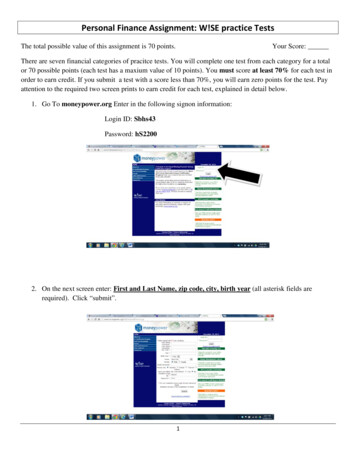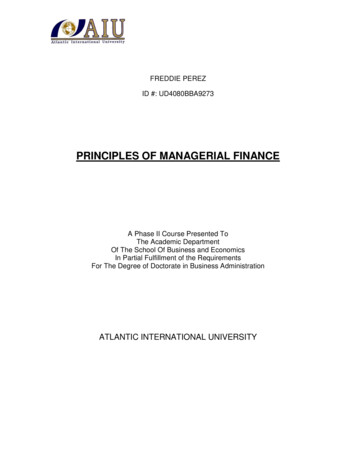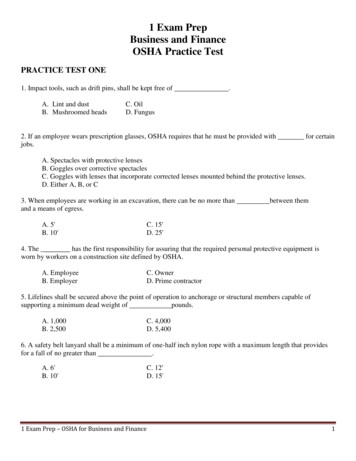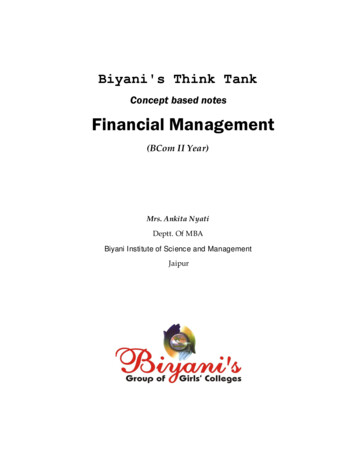
Transcription
A Guide toPer sonalFinanceOptionsFINANCIALbasics
Moore, J. (2014). Financial basics handbook. (A. Moyer, Ed.). Raleigh, NC:Workplace Options.Copyright 2015 by Workplace Options
Table of ContentsIntroduction .4Understanding Money Management.4Setting Financial Goals.4Tracking Expenses.5Creating a Budget .5Making Changes to Your Spending Plan.8Staying Motivated.9Managing Your Debt .9Credit Cards and Personal Loans.9Student Loans.11Deferment and Forbearance.12Payday Loans.12Collection Agencies .13Your Credit Report .13Accessing Your Credit Report.14Your Rights.14Your Credit Score.15Errors, Fraud, and Identity Theft.16Home Ownership.18Types of Mortgages .19Home Equity.19Reverse Mortgages.20If You Can’t Make Your Payment .20Investing .21Stocks.21Bonds .22Cash Equivalents.22Risk Management.22Planning for Retirement. 23Employer-Sponsored Retirement Plans .25Individual Retirement Accounts .25Financial Advisors .25Conclusion. 26
IntroductionYou face decisions about personal financesevery day. From budgeting and saving to creditand debt to planning for the future, the issuessurrounding money choices can feel challengingor even overwhelming. However, by takingcontrol of your money and how you spend,save, and invest it, you can push past yourfinancial challenges and reach your goals.Understanding MoneyManagementThere are probably quite a few things you’d likeyour money to do for you beyond just coveringyour day-to-day living expenses. Perhaps you’dlike to take an exotic vacation, buy a house,send your children to college, or retire early. Bydefining your financial goals and keeping thosea priority in the money choices you make, you’llbe able to develop a financial focus on what’smost important to you.SETTING FINANCIAL GOALSThe first step in setting achievable financial goalsis to clarify what you want. Like most people,you may have multiple goals you would like toachieve over time. Consider which of thosegoals are most important.You may be able toreach them all, but prioritizing will help youmake sure that the most important goals aretaken care of first. If you share your financeswith another person, take some time to talktogether about what you would like to achievefinancially and what each of your prioritiesare. Once you’ve decided what you’d like yourmoney to do for you, break it down into timeframes: Short-term goals are typically goals that youcan reach in a year, such as saving for a newcomputer or a down payment for a car.4 · FINANCIAL BASICS HANDBOOK Mid-range goals, like saving for a downpayment on a house or repaying credit carddebt, typically take 1 to 5 years to reach. Long-term goals stretch beyond the 5-yearmark and are often high-dollar goals likeretirement or college tuition for the kids.It’s important to break savings goals into timeframes so you can best decide where to stashyour cash. For short-term goals, you wouldmost likely use a basic savings account. However,for mid-range and especially long-term savingsgoals, you would be better off putting themoney into accounts that generate a higherinterest rate while not providing access to themoney.These accounts, especially for retirementand college planning, may have favorable taxadvantages as well.Now that you know what you want andgenerally when you want it, it’s time to getspecific. By assigning a dollar figure andachievement date to your goals, you’ll knowhow much money to direct to each one eachmonth.This is pretty simple for short-termgoals; simply divide the amount you need bythe number of months, and you’ll know what toput aside. For longer-term goals, you may needto use an online compound interest calculator(you can find a good one on The CalculatorSite at http://www.thecalculatorsite.com/, in the Finance Calculatorssection) to calculatethe power of
compounding interest, interest added to theprincipal, which is the amount you borrow, ofa deposit or loan so that the added interestearns interest as well, working against you if youare paying off credit card debt, or working inyour favor in the case of retirement or collegeplanning. If you are currently contributing toa retirement account or have one availablethrough your employer, you can talk to arepresentative of the company that managesyour plan for help with the calculations.Measuring your progress toward your goalscan be extremely motivating.You can set upmultiple accounts at your bank or credit unionand have the money you’ve decided to setaside directly transferred to the appropriateaccount. Keep an eye on your balances to seeyour progress toward your goal amounts. If,over time, your goals change, you can move themoney around to pursue your new financialgoal.TRACKING EXPENSESKnowing what you need to set aside to reachyour financial goals within your time frame isa great first step toward making your moneywork for you.The next step is to look at whatmoney you have coming in and going out soyou can ensure you have the funds availableto meet your needs and fund your goals.Todo this, start by tracking your expenses.Thisincludes the couple of dollars you might spendon coffee or a snack throughout the day, aswell as bigger expenses like grocery shopping,gas for your car, and your monthly bills.You cando this as low-tech as just jotting down theamounts in a notebook, or by using one of themany apps or software tools developed for thisvery purpose.Tracking your expensesfor a week is enlightening.Doing it for a couple ofmonths, however, will giveyou an excellent pictureof where your money goes.You may even findthat tracking expenses and being accountableto yourself (and to someone else if you shareyour finances and are doing this together)helps curb impulse purchases. Many people areless likely to buy things they don’t really needif they know they’ll have to write it down andexperience the consequence of the purchaseon paper.CREATING A BUDGETWhile many people associate the wordbudget with limitations or sacrifice, in realityit’s just a plan for how you will spend andsave the money you make. Start with yourincome. Using a budgeting program, an Excelspreadsheet, or old-fashioned pen and paper,put down what you make each month. Be sureto include all sources of income, documentedor otherwise, for everyone contributingfinancially to your household in your budget.The net income, the amount you bring home, iswhat’s most important here. Finding what thatis for a month can be slightly tricky, as there aremore than 4 weeks in a month: If you’re paid monthly, use that number. If you’re paid twice a month (for example,on the 1st and the 15th of the month)multiply your take-home pay by 2. If you’re paid every 2 weeks (for example,on alternate Fridays) multiply your takehome pay by 26 and divide by 12. If you’re paid weekly, multiply your weeklypay by 52 and divide by 12.FINANCIAL BASICS HANDBOOK · 5
If your pay varies throughout the year, lookat what you made last year. If it seemsrealistic that you’ll do the same this year,divide last year’s take-home pay by 12 toproject this year’s average monthly income.If you project you’ll make much more orless, modify your projection for this yearaccordingly. On months that you bringhome more than the projected amount, besure to set aside the extra funds to covermonths when you bring home less. If you are eligible to receive an annualbonus, don’t include that as part of yourregular income for your ongoing budget,but keep in mind your financial goals whendeciding on how to spend it.While your budget will mainly be driven byyour take-home pay, this is also a good time tolook at your tax withholdings. If you’re havingmore money than necessary taken out of yourpaycheck so you can get a large refund, youmay be better off changing that and moving theextra money to an interest-bearing account orinto your monthly cash flow. If you’re not havingenough withheld and end up owing the InternalRevenue Service each year, consider modifyingyour withholdings so you don’t have a difficulttax debt burden on your hands in the spring.6 · FINANCIAL BASICS HANDBOOKIf you’ve been tracking your expenses, thengetting started with making a plan for how tospend your money will be pretty simple. Evenif you haven’t, an honest assessment of whatyou think you spend is a good starting point. Ifyou use a debit or credit card for many of yourexpenses, a review of your recent statementswill help. Expenses can usually be broken downinto two sets of categories: essential expensesversus discretionary expenses, and consistentexpenses versus periodic expenses.Essential expenses are things you simply needto have. For most people this includes things likehousing, transportation, and food. Discretionaryexpenses are things you want to have, suchas dining out, entertainment, and vacations.Consistent expenses arise each month, like yourrent or mortgage payment. Periodic expenseshappen only once in a while, such as car repairs.Consistent and periodic expenses may beessential or discretionary.This chart is an example of different expensesand how they break down into these categories.You may not have all of the ones listed andmay have additional expenses. Further, what’sessential to one family may be discretionary toanother. Use this chart to start thinking aboutyour expenses and which are most importantto you.
ansportationFoodChild careDebt repaymentSavingsCable televisionGym membershipEntertainmentDining outCoffeeHobbiesPERIODICProperty taxesHome or auto repairsMedical expensesClothingVacationGiftsAs you are listing your expenses for your budget, start with your consistent essential expenses.Some of these, like utilities, will vary throughout the year.Try to find the average amount for a year,and use that for your budget plan. Next, determine what you think you’ve spent in the past yearon periodic essential expenses, and decide if you think that’s a realistic amount for the coming year.Be brutally honest with yourself. For example, if you’ve had no home or auto repairs for the pastfew years, you may be tempted not to budget for any. However, if you have an older home or yourcar has been on the road for a while, you may be due for some maintenance costs. Once you’vedecided on your amounts, divide them by 12 and add them to your spending plan.You can havethose funds automatically transferred into a savings account you can turn to so you don’t have toresort to credit cards when the roof starts leaking.Go through the same process with your consistent and periodic discretionary expenses.Thesemay be a bit more challenging, because they are less likely to be specific bills to pay than theyare miscellaneous unplanned expenditures that some people call spending money. If you haven’tbeen tracking your spending, use your debit and credit card statements to get your best guess. Bytracking your expenses going forward, you can fine-tune this area.Payments to your creditors will need to be included in your budget. For your first draft, just includeyour minimum payments. If one of your goals is to get out of debt, you can increase the paymentsafter you determine that your essential expenses are covered. If you have high-interest debt, payingonly the minimum payment can lock you into payments for decades and cost you a fortune ininterest and fees. It’s in your financial best interest to find the funds to increase these payments.Savings is an often-overlooked but essential part of any budget or spending plan. For most people,having easily accessible funds in an emergency savings account is critical.Work toward putting away3 to 6 months of your essential expenses in this account. If you have an unexpected crisis, this canFINANCIAL BASICS HANDBOOK · 7
make the difference in keeping your head abovewater. Once you’ve established your emergencysavings, you can focus on saving for goals.ahead, you are ready to put your plans in placeto reach your goals. If there’s a shortfall, don’tdespair.You have options.In your budget, include the dollar figures youdetermined would need to be set aside toreach your goals in the timeline you chose.Some of that money may be earmarked torepay debt more aggressively, some may beused to increase contributions to a retirementplan, and some may be going to a basic savingsaccount to cover next year’s holiday expenses.No matter what the money is for, be sure tonote it in your budget plan.MAKING CHANGES TO YOURSPENDING PLANNow that you have your income and expenses,including debt payments and savings accountedfor, it’s time to put it all together. Add togetherall of your expenses and subtract them fromyour income. If you break even or come outWhen your numbers just don’t add up, you areleft with three options: increase your income,decrease your expenses, or postpone reachingyour goals. If your income is sufficient to coveryour basic living expenses but not enough tosave as much for your goals as you’d like, youcan choose between drawing out the goalperiod or making changes to your budget. Ifyour income isn’t covering your basic expenses,you’ll certainly need to look at making changes.You may have some options for increasingincome: If you get a large tax refund each year,modify your withholdings to get that moneyin your paycheck. Explore part-time work. Encourage other members of yourhousehold to contribute to thehousehold expenses. Sell assets. Be aware, though, that liquidatingcertain assets may have tax consequences.Many people find that it’s easier to adjust theirexpenses than their income.This can be done ina variety of large and small ways. Make and pack your own coffee, lunch, andlunch for the kids. Reduce dining out expenses by meetingfriends for coffee or other less expensiveactivities. Refinance your mortgage or car loan if youcan qualify for a lower rate and the longterm cost is reasonable. Shop sales and use coupons. If you have a cell phone, cancelyour land line. Reduce or eliminate cable television. Use public transportation or carpool.8 · FINANCIAL BASICS HANDBOOK
These are just a few ideas to get you startedthinking about changes you can make. Gettogether with everyone you share yourhousehold finances with, and look at whatyou’ve been spending. Figure out togetherwhat’s most important to you and what thingsyou might be willing to reduce or even dowithout. Look honestly at your wants andneeds, and compare those with your goalsto see what you value the most. By makingeducated choices about your money, you cantake control of your spending plan and reachyour financial goals.STAYING MOTIVATEDUsing a balanced spending plan to manageyour money and work toward your goals canbe very satisfying. However, it’s easy to losemotivation over time. If you fear you’ll betempted to throw all of your careful trackingand planning out the window after a fewmonths, try some of these methods to staymotivated: Put pictures of your goals everywhere!Put one in your wallet, one on yourcomputer, one on your front door, or oneanywhere else you can think of that willhelp you remember what all of this is for. Avoid temptation. If you’re trying to cutdown on shopping, stay out of the mall andunsubscribe from e-mails from yourfavorite stores.Put a bit of money in your budget plan forsmall luxuries, or schedule a reasonablereward for hitting certain savings or debtrepayment benchmarks. Monitor your accounts. Watching yourbalances grow each month can keep yourenthusiasm levels high. Be kind to yourself. You may veer offcourse from time to time.That’s not afailure; it’s just a setback. Return to yourplan, revise it if necessary, and keep going.Managing Your DebtWhile certain types of debt can be aninvestment in your future, excessive debtcan easily derail your plans for your money.Incorporating into your personal financial planan assertive strategy to manage and deleteyour debt can help you save over time and usemore of your money to reach your goals.CREDIT CARDS AND PERSONALLOANSCredit cards provide convenience, especiallywhen traveling, and many have inviting perkslike airline miles or cash back on purchases.Overuse of credit cards, however, can beextremely expensive.The combination ofincreasing balances, low minimum payments,fees, and high interest rates can result in years Solicit help. Let yourfriends and loved ones knowwhat you are doing so theycan support you and notinadvertently tempt you byinviting you shopping or toexpensive restaurants. Instead,you can plan less expensiveget-togethers. Budget for small treatsand rewards. Don’t denyyourself every pleasure in life.FINANCIAL BASICS HANDBOOK · 9
your creditors know thatyou’re considering transferringyour balances elsewhere, andyou may find yourself with abetter rate.of repayment and thousands of dollars ininterest and fees. Paying off your credit carddebt or personal loans efficiently is a matterof making sure your payments significantlyoutweigh your use, as well as the monthlyinterest.If your goal is to get out of debt, the first stepis to stop using your credit cards.This can bechallenging, but if you’ve created a balancedspending plan and set aside some cash foremergencies, it will be easier. If you choose tokeep a credit card in use because of its perks orfor the protection it may provide for travelingand large purchases, be sure that you pay forany new charges each month, as well as atleast the requested minimum payment.Thiswill keep you on track for getting out of debtwhile you take advantage of the benefits thecard provides.The low minimum payments that many creditcards offer can make repayment feel easy in theshort term but end up costing a fortune in thelong term.To speed up the repayment processand save money, consider ways to increase yourpayments.These may be reducing nonessentialexpenses to increase payments consistently,or occasional payment blasts when you get abonus, a large commission, or other windfall.The other key factor in efficient debt repaymentis reducing interest rates. Depending on yourcredit standing and other financial factors, youmay have quite a few options to explore. Request reduced rates—The world ofcredit is competitive. If you have a decentcredit history, it’s likely that several financialinstitutions will vie for your business. Let10 · F I N A N C I A L B A S I C S H A N D B O O K Transfer balances—If your financialinstitution won’t give you a low rate,find one that will. If you’re gettingpreapproved offers in the mail for a lowrate card, look into making the switch.Both http://www.consumerreports.com/ andhttp://www.bankrate.com/ provide detailsand comparisons of financial products. If youdecide to transfer your balances, checkthe fine print to be sure that the lowrate being advertised will last morethan a few months, and that it won’tskyrocket to an exorbitant one. Tap into home equity—If you have equityin your home, meaning that your home isworth more than you owe on it, you maybe able to refinance your mortgage or geta home equity loan at a lower rate, whichyou can then use to repay your higher-costdebt.There may even be tax advantages tothis strategy. Consider this option carefullybefore jumping in, however, and look atthe total cost of the new loan.The closingcosts and the fact that most home loansare repaid over a longer period of time maymake this option as expensive as the originalhigher-rate debt. Additionally, if you findyourself unable to make the new payment,you can be putting your home at risk. Debt repayment plans—Many creditcounseling organizations offer structureddebt repayment plans to help consumersget out of debt.They negotiate withcreditors on behalf of consumers to try toreduce interest and fees.The consumer paysthe debt, plus a monthly fee, through thecredit counseling agency over a 3- to 5-yearperiod. Depending on which creditorsyou owe, this can be an efficient way toget out of debt but can also have creditconsequences.
Many debt repayment strategies involve movingbalances to new accounts, which leaves theold accounts with a zero balance. For somepeople, this is an invitation to go on a spendingspree. If you think you’ll be tempted to overdoit, plan to close those old accounts. Keepingthem open may bring some benefits to yourcredit score, a number assigned to your credithistory indicating the level of risk you representto lenders; however, if it’s going to result inoverwhelming debt, close them and work onyour credit score through other strategies.Some organizations offer debt settlementnegotiation, a repayment strategy in which youoffer to pay a lump sum that’s less than yourbalance to a creditor if the creditor agreesto consider the debt paid in full.This canbe expensive, can result in significant creditdamage, and doesn’t always work. If youraccounts are current, there is little incentive fora creditor to take less than the amount owed.If you have older accounts with collectionagencies, however, you may be able to makethis kind of an arrangement on your own. Makeyour offer in writing, and make sure you getthe agency’s commitment in writing. Be awarethat there may be some tax consequences to asettlement, and you may get notification at theend of the tax year that you owe taxes on theportion of the principal that was forgiven.STUDENT LOANSStudent loans are a significant financialchallenge for both young people right outof college and those who are still strugglingwith getting them paid off years later.They areunique loans with a variety of repayment planoptions and certain flexibility in deferring, orsuspending, payments that many other types ofloans don’t have. However, there are significantconsequences of nonpayment of student loans.These loans are very difficult to discharge inbankruptcy, and if unpaid, can haunt your creditreport for years to come, beyond the 7-yearreporting period for most debts.It’s not unusual for student loan borrowers tohave multiple loans, both private and federal.Generally, students first maximize their federalstudent loans and other sources of financial aidgranted through their financial aid applicationpackage, and then make up the differencewith private student loans that come directlyfrom financial institutions, which may bemore expensive and have less flexibilitythan federal loans.Based on your loan combination, you may beable to consolidate multiple loans into one newloan.This can make repayment simpler, possiblylower your interest rate, lower your monthlypayment by extending the loan, and even bringdelinquent accounts current. However, youmay lose some rights to cancel your loans, andthe loans can cost more in the long term if therepayment term is extended.You can shop forconsolidation loans through private lendersand the U.S. Department of Education athttp://www.ed.gov/.F I N A N C I A L B A S I C S H A N D B O O K · 11
DEFERMENT AND FORBEARANCEIf you’re going through a short-term hardship,you may be able to suspend payments on yourfederal student loan for an agreed-upon periodof time, typically in increments of 3 or 6 months.These payment suspensions are known asdeferments or forbearance. A defermentmay include suspending interest ratesand is typically granted to Students with at least half-time enrollment Active-duty military members Those suffering from a temporary totaldisability Unemployed borrowersA forbearance allows borrowers to suspendor reduce payments, but interest will continueto accrue on the loan. Because interest may besuspended for a deferment, it’s often consideredthe more desirable choice by borrowers.However, a forbearance may be easierto get approved for.Some borrowers can qualify for cancellationor forgiveness, eliminating the responsibilityof repayment of some or all of their federalstudent loans in cases of permanent disabilityor in which the borrower works in certain highneed fields and communities, such as teaching,health care, legal assistance, or as a governmentvolunteer.1There are several repayment plans available forfederal loans, and many private lenders offersimilar plans. If the monthly payments for yourstudent loans are too high for you to afford,contact your lender about an alternative plan. Extended plan—This plan can allow youto draw out your repayment period fromthe standard 10 years, up to 25 years. Beaware that interest will accrue throughoutthis period, so extending your loan will cost1 FinAid. (n.d.). Loan forgiveness. Retrieved September 28, 2014, fromhttp://www.finaid.org/12 · F I N A N C I A L B A S I C S H A N D B O O Kmore in thelong run unlessyou eventually accelerateyour payments. Graduated plan—If it is likely that yourincome will increase over time, a graduatedpayment plan may be appropriate for yourneeds. Payments start very low and areincreased every 2 years. Income-contingent plan—In this plan,your financial circumstances are assessed bythe lender annually, and the payments areadjusted accordingly.PAYDAY LOANSPayday loans, whet
Management There are probably quite a few things you’d like your money to do for you beyond just covering your day-to-day living expenses. Perhaps you’d like to take an exotic vacation, buy a house, send your children to college, or retire early. By defining your financial goals and kee











